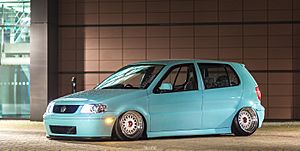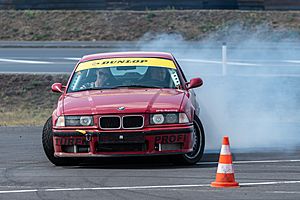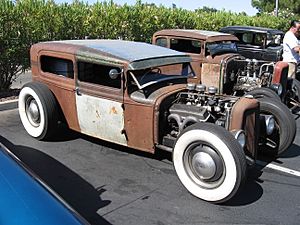Car tuning facts for kids
Car tuning is when people change a car to make it perform differently or look unique. Most often, this means making the engine more powerful or improving how the car handles. But cars can also be changed to save more fuel or have a smoother ride. The main goal is to make the car better for what the owner wants. Sometimes, making a car faster can mean it uses more fuel or parts wear out quicker.
Over time, a whole culture has grown around modified cars. So, "tuning" also includes changes people make to personalize their vehicles. These changes can be functional, like improving how the car works, or just visual, like changing its appearance. Sometimes, visual changes might even make the car perform a little worse.
Car tuning is connected to auto racing, even though many tuned cars don't compete in official races.
Contents
Where Did Car Tuning Start?
Cars have been changed by their owners almost since they were invented. In the past, people would modify cars to make them faster, like the famous "Hot Rods" from the 1940s. Companies like Abarth and Cooper even became famous for modifying cars. Cosworth, with help from Ford, started by changing engines and later became a big name in Formula One racing.
In the 1970s and 1980s, many cool Japanese performance cars were only sold in Japan. But in the late 1980s and early 1990s, people started bringing these cars, like the Nissan Skyline, into countries like the United States and Europe. At that time in the U.S., most performance cars were big muscle cars like the Ford Mustang.
Because smaller, lighter cars became popular and tuning parts became cheaper, people found they could make these cars very fast without spending a lot of money. As professional racing with these cars grew, so did the hobby of tuning them. Many drivers started modifying their cars to look and perform like race cars.
How Cars Are Changed
The main idea behind tuning a car is to make it perform much better than it did from the factory. This often means changing the engine to get more power. But to handle that extra power, other parts also need to be upgraded. This can include making the suspension stiffer, using wider tires, adding better brakes, and improving the steering or transmission. Even though some changes might not seem to affect the look much, things like lower tires or spoilers can change how a car appears. Spoilers can also help the car stick to the road better at high speeds.
Engine Power-Ups
Engine tuning means changing how an engine works. Modern cars have a computer called an engine control unit (ECU) that manages everything to balance power and how clean the exhaust is. Tuners can change the software in this computer, which is like giving the car a new set of instructions. This is called "chip tuning" or "mapping."
Another way to add power is to install forced induction systems, like turbochargers or superchargers. These devices push more air into the engine, making it burn more fuel and create more power.
It's important to know that if engine changes are not done correctly, they can damage the engine. For example, adding too much power can cause parts to break or the engine to overheat. This can lead to very expensive repairs and can even be dangerous.
Making Cars Handle Better
Suspension tuning involves changing parts like springs and shock absorbers. Shorter springs make the car stiffer and lower its center of gravity, which helps it corner better. Stiffer shock absorbers also help the car handle turns. Stiffer anti-roll bars reduce how much the car leans when turning, which helps the tires grip the road.
Sometimes, people add strut bars to make the car's body stiffer. This helps the suspension work better during turns. For off-road vehicles, the goal is often to make the suspension travel longer and add bigger tires. Bigger tires help the vehicle go over rough ground more easily and provide a smoother ride.
Lowriders use a special type of suspension. They have hydraulic or air systems that let the driver quickly change the height of each wheel. This allows them to make the car "dance" or even bounce off the ground!
Changing the Car's Look
Body tuning means changing the car's exterior. This can be to make it look different, improve how it performs, or both. For example, some changes can make the car more aerodynamic, helping it stick to the road better, especially at high speeds. To make a car lighter, parts like the hood or side mirrors might be replaced with lighter materials.

Often, body changes are just for looks. Things like non-working scoops or wide body kits might not improve performance at all. In fact, many aftermarket spoilers or body kits can add weight and make the car less aerodynamic, actually slowing it down.
Sometimes, people lower a car's suspension just for its appearance, even if it makes the ride less comfortable. This is called "stancing" a car.
Sound Systems
Many people upgrade their car's sound system. This can be as simple as changing the radio or as complex as building a custom setup with many speakers and amplifiers. Some people even compete to see who has the loudest or best-sounding car audio system. Common upgrades include better speakers, subwoofers, and stronger amplifiers.
Interior Changes
For race cars, the interior is often stripped out to save weight. Things like audio systems, air conditioning, and soundproofing are removed. This helps the car be lighter and faster. Race cars also need special safety features like roll cages (a strong frame inside the car), fire extinguishers, and special seats with safety harnesses. These features protect the driver in case of a crash.
Different Styles of Tuned Cars
Tuned cars can look very different from their original versions. Often, owners try to make their cars fit into certain styles. Here are some popular tuning styles:
- Rat rod: These cars look "unfinished" or old, like hot rods from the 1940s to 1960s. They often have visible wear and tear.
- Euro style: These cars are usually lowered and have unique paint jobs and smaller wheels.
- Lowrider: Known for their hydraulic or airbag suspensions that allow them to bounce. They often have custom paint and special wire wheels.
- JDM or Import: These are Japanese cars modified with aftermarket parts and race-inspired details.
- Dub or donk: These cars have extremely large, flashy wheels with thin tires, loud sound systems, and are usually lifted very high.
- Slab: A style from Houston, Texas, usually seen on large American luxury cars. They have special "elbow" wheels that stick out, loud speakers, and unique trunk designs.
- Bōsōzoku: A Japanese style, often on motorcycles, with exaggerated exhausts and body parts.
- VIP style: A Japanese style for luxury cars, often lowered with large, fancy wheels.
- Stanced: Cars with very low suspension setups and custom wheels that are often angled inwards (negative camber) for a unique look.
- Hot rod: Classic cars modified to look like early drag cars from the 1930s and 1940s.
- Sleeper: Cars that look completely stock on the outside but have powerful performance upgrades hidden underneath.
- Rally car: Cars built to compete in rallies, which are races on various terrains.
- Drift car: Cars specially built for drifting, a style of driving where the driver intentionally oversteers.
- Drag car: Cars modified for maximum straight-line speed and acceleration.
- Restomod: Classic cars that keep their original look but have modern technology inside, like new suspension or multimedia systems, for comfortable daily use.

Tuning Terms You Might Hear
Here are some common words used in the world of car tuning:
- BOV (blow-off valve)
- A valve on turbocharged engines that releases pressure when you take your foot off the gas. This protects the engine and often makes a cool "hissing" sound.
- CAI (cold air intake)
- A modified air intake system that brings colder air from outside the car into the engine. Colder air helps the engine make more power.
- Catback
- The part of the exhaust system that is after the catalytic converter.
- Custom tune
- A special software change for a car's computer that is made just for that specific car and its modifications.
- Decat
- An exhaust pipe without a catalytic converter. This makes the car louder and can sometimes make flames shoot out of the exhaust.
- Dyno
- Short for dynamometer. This is a machine that measures how much power a car's engine makes.
- Log
- A recording of how the car or engine is working, like its speed, engine RPM, or temperature, while it's being driven.
- Map
- The software settings for the car's engine computer (ECU). A "map" tells the engine how to run.
- Pull
- When a car accelerates at full throttle in a straight line, usually to measure its power or record data.
- Stage 1, 2, 3
- These terms describe how much a car has been modified for performance.
- Stage 1: Simple changes, often just a software tune, for a small power boost.
- Stage 2: More changes, like a full exhaust system and a stronger tune, for a bigger power increase.
- Stage 3: Major changes to the engine and other parts, like a bigger turbo, for a very significant power boost.
- Stock map
- The original software settings for the car's engine computer, as it came from the factory.
- Tune
- A modified software map for the engine computer, usually to increase power. This is often done using a special device connected to the car.
- Tuner
- A person or company that creates and sells modified software (tunes) for cars, and often sells other performance parts.
- Turbo lag
- The small delay between when you press the gas pedal and when a turbocharger starts giving the engine full power.
Rules and Safety
Many countries and cities have rules about car modifications. These rules help make sure cars are safe to drive on public roads. For example, some places have "smog regulations" that limit changes to engines to control pollution. Even if a modification doesn't cause more pollution, it might still be illegal if it's not approved.
Organizations involved in car racing have even stricter safety rules. Groups like the NHRA require cars to pass inspections to make sure they are safe for racing.
See also
 In Spanish: Tuneo para niños
In Spanish: Tuneo para niños




